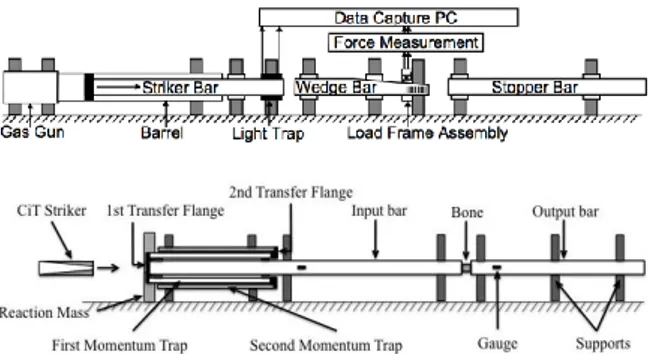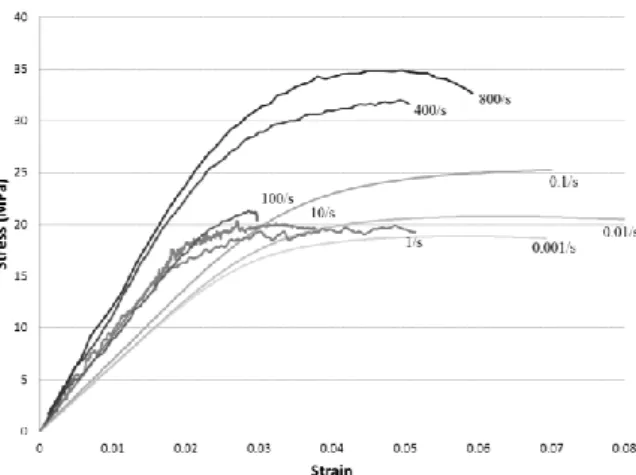Science Arts & Métiers (SAM)
is an open access repository that collects the work of Arts et Métiers Institute of
Technology researchers and makes it freely available over the web where possible.
This is an author-deposited version published in: https://sam.ensam.eu Handle ID: .http://hdl.handle.net/10985/8781
To cite this version :
Marianne PROT, Trevor John CLOETE, Dominique SALETTI, Sébastien LAPORTE
-Intermediate strain rate behavior of cancellous bone: From the lower to the higher strain rate - In: SB2014, France, 2014-08 - Computer Methods in Biomechanics and Biomedical Engineering, 17:sup1, 50-51 - 2014
Any correspondence concerning this service should be sent to the repository Administrator : archiveouverte@ensam.eu
* Corresponding author (email: marianne.prot@ensam.eu)
Intermediate strain rate behavior of cancellous bone:
From the lower to the higher strain rate
M. Prot
†*, T. J. Cloete
‡, D.Saletti
†, S. Laporte
† †Laboratoire de Biomécanique, Arts et Métiers ParisTech, 151 Boulevard de l'Hôpital, 75013 Paris
‡ Blast Impact and Survivability Research Unit (BISRU),Department of Mechanical Engineering, University of Cape
Town (UCT), Private bag X3, Rondebosch 7701, South Africa
Keywords: Cancellous Bone; Intermediate Strain rate; Interrupted tests; Quasi-Static; Dynamic.
1. Introduction
A better understanding of bone fracture is necessary to improve the musculoskeletal modeling of the human body. While the global strength of the skeleton is primarily due to the mechanical properties of compact bone, injury to cancellous bone can lead to vascular problems or local compaction. Cancellous bone has a porous structure that protects the marrow, acts as a core material to support the bone shape and assists in transferring joint forces to the thick load bearing cortical bone layers.
Mechanical properties of cancellous bone, over a large range of strain rates, are needed for the development of new mechanical models of the human body. These models are required to better simulate and understand injuries sustained during a car crash or sporting accident, especially at medium energy levels. The majority of studies have focused on quasi-static loading, while relatively few have considered the mechanical characterization at high strain rates (Chaari 2007). Furthermore, there does not appear to be any published study on the mechanical properties of cancellous bone at intermediate strain rates.
The aim of this study is to characterize the mechanical properties of cancellous bovine bone under compression loading for different strain rates, including the intermediate regime.
2. Materials and Methods
2.1. Specimen
Cylindrical cancellous bone specimens (length: 7.5mm; diameter: 10.5mm) were extracted from the epiphyses of bovine femoral bones while recording the anatomical position. The non-defatted specimens were kept in a saline solution, in a frozen condition. 155 samples were divided into three strain rate conditions: quasi-static, dynamic and intermediate strain rate.
2.2. Quasi-Static tests
Compression tests at constant strain rates of 0.001 /s (10 bones), 0.01 /s (10 bones), 0.1/s (25 bones) were performed on a Zwick universal testing machine.
2.3. Intermediate strain rate tests
Cancellous bone behaviour in the intermediate strain rate (ISR) regime was investigated using two recently developed techniques (Cloete 2014), i.e. the Wedge-Bar apparatus and the split Hopkinson pressure bar (SHPB) technique implemented with a cone-in-tube (CiT) striker (cf. Figure 1), both of which can provide constant strain rate conditions.
Figure 1: Wedge bar apparatus (Cloete 2014), and SHPB with CiT striker implemented with Momentum Trap.
2.3.1. Wedge Bar intermediate strain rate
50 specimens were divided in two groups of compression tests with the wedge bar apparatus: one group was subjected to a strain rate of 1/s while the second one was compressed at 10/s. All the tests were conducted at near constant strain rates and load path equilibrium was typically attained within 1% specimen strain.
2.3.2. Cone in tube intermediate strain rate
50 specimens were divided into two groups of compression tests with the CiT striker and the SHPB apparatus: specimens were compressed at a rate of 100/s and approximately 400/s. The system was equipped with a momentum trap system (Prot 2012).
2.4. Dynamic tests
High strain rate compression tests were conducted using the same SHPB technique as discussed above, but with a shorter CiT striker. This set up allows the specimen to experience a single compression wave of a known amplitude and duration. 10 specimens were loaded at strain rates between 500/s and 1000/s.
3. Results and Discussion
Results for the second strongest sample, in regards with the ultimate stress, for each strain rate category, are depicted in Figure 2.
Figure 2: Stress-Strain responses for different strain rates The data confirms that cancellous bone is strain rate sensitive with a non-linear response. It suggests that a transition in the behaviour occurs at intermediate strain rate, i.e. 1 to 100 /s.
Results at low strain rates were found to be consistent with the literature. The high strain rate results show the same trend as that observed by (Shim 2005) in human cervical cancellous bone. Given the novel nature of the intermediate strain rate results for cancellous bone presented in this study, no comparison with the literature could be made. However, the results are consistent with lower and higher strain rate behavior. It appears that fracture occurs earlier at intermediate strain rates (0.03 strain versus 0.04 for lower and higher strain rate). Note that the intermediate strain rate data was obtained using two different techniques and, therefore, the distinct intermediate strain rate behaviour is not an artifact of any particular testing method.
In addition to the rate sensitivity, the bone specimens also displayed a strong dependence on density and orientation due to the inherent anisotropy of cancellous bone. Further work is underway to characterize the micro-architectural parameters, so as to explain the variation of strength observed at a given strain rate (cf. table 1). Table 1: Inter-individual variations of ultimate Stress
4. Conclusions
Novel data for cancellous bone behavior at intermediate strain rates, obtained using two different dynamic testing techniques (i.e. a Wedge-Bar and a SHPB with a CiT striker), is presented.
This study confirms previously published work showing that the behaviour of cancellous bone is strain rate dependant. In addition, this study indicates that the transition occurs in the intermediate strain rate range (i.e. 1 to 100 /s). Ongoing work using micro-CT scans of the specimens, in both the pre- and post-tested condition, is aimed at the investigation of rupture propagation at the microstructural scale. Furthermore, the scans will be used to investigate and explain the scatter observed in the experimental results.
Future work using confined tests at intermediate and high strain rates will allow the role of bone marrow in the fracture process to be investigated.
Acknowledgment
The authors wish to thank Sacks Butcheries for supplying the bovine femurs, Mr. C Harris (UCT) for the machining of the specimens, Ms. P Park Ross (UCT) for her assistance with the Zwick Machine and the UCT Research Committee for the financial support to conduct this work.
References
Chaari F, Markiewicz E, Drazetic P. 2007. Identification of the spongy bone mechanical behaviour under compression loads: numerical simulation versus experimental results. Int J Crashworthiness, 12(3), pp. 247-253.
Cloete TJ, Paul G, Ismail EB. 2014. Hopkinson bar techniques for the intermediate strain rate testing of bovine cortical bone. Phil. Trans. R. Soc. A 2014 372, 20130210.
Prot M, Cloete TJ, Pattofatto S. 2012. Dynamic compression and recovery of cancellous bone for microstructural investigation. DYMAT 2012, EPJ Web of Conferences 26, 03003. Shim VPW, Yang LM, Liu JF, Lee VS. 2005.
Characterization of the dynamic compressive mechanical properties of cancellous bone from the human cervical spine. Int J Impact Eng,32, pp. 525–540.

